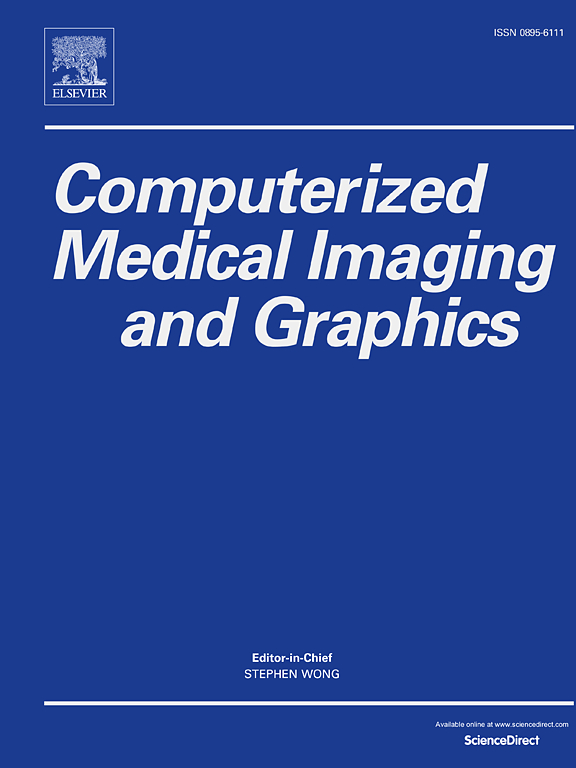DSIFNet: Implicit feature network for nasal cavity and vestibule segmentation from 3D head CT
IF 5.4
2区 医学
Q1 ENGINEERING, BIOMEDICAL
Computerized Medical Imaging and Graphics
Pub Date : 2024-11-12
DOI:10.1016/j.compmedimag.2024.102462
引用次数: 0
Abstract
This study is dedicated to accurately segment the nasal cavity and its intricate internal anatomy from head CT images, which is critical for understanding nasal physiology, diagnosing diseases, and planning surgeries. Nasal cavity and it’s anatomical structures such as the sinuses, and vestibule exhibit significant scale differences, with complex shapes and variable microstructures. These features require the segmentation method to have strong cross-scale feature extraction capabilities. To effectively address this challenge, we propose an image segmentation network named the Deeply Supervised Implicit Feature Network (DSIFNet). This network uniquely incorporates an Implicit Feature Function Module Guided by Local and Global Positional Information (LGPI-IFF), enabling effective fusion of features across scales and enhancing the network's ability to recognize details and overall structures. Additionally, we introduce a deep supervision mechanism based on implicit feature functions in the network's decoding phase, optimizing the utilization of multi-scale feature information, thus improving segmentation precision and detail representation. Furthermore, we constructed a dataset comprising 7116 CT volumes (including 1,292,508 slices) and implemented PixPro-based self-supervised pretraining to utilize unlabeled data for enhanced feature extraction. Our tests on nasal cavity and vestibule segmentation, conducted on a dataset comprising 128 head CT volumes (including 34,006 slices), demonstrate the robustness and superior performance of proposed method, achieving leading results across multiple segmentation metrics.
DSIFNet:用于从三维头部 CT 中分割鼻腔和前庭的隐含特征网络
这项研究致力于从头部 CT 图像中准确分割鼻腔及其复杂的内部解剖结构,这对了解鼻腔生理、诊断疾病和规划手术至关重要。鼻腔及其解剖结构(如鼻窦和鼻前庭)具有明显的尺度差异、复杂的形状和多变的微观结构。这些特征要求分割方法具有强大的跨尺度特征提取能力。为了有效应对这一挑战,我们提出了一种名为深度监督隐含特征网络(DSIFNet)的图像分割网络。该网络独特地集成了由本地和全局位置信息(LGPI-IFF)引导的隐式特征功能模块,从而实现了跨尺度特征的有效融合,并增强了网络识别细节和整体结构的能力。此外,我们还在网络解码阶段引入了基于隐式特征函数的深度监督机制,优化了多尺度特征信息的利用,从而提高了分割精度和细节表示能力。此外,我们还构建了一个由 7116 个 CT 卷(包括 1,292,508 个切片)组成的数据集,并实施了基于 PixPro 的自监督预训练,以利用未标记数据增强特征提取。我们在由 128 个头部 CT 卷(包括 34006 张切片)组成的数据集上进行了鼻腔和前庭分割测试,测试结果证明了所提方法的鲁棒性和卓越性能,在多个分割指标上都取得了领先的结果。
本文章由计算机程序翻译,如有差异,请以英文原文为准。
求助全文
约1分钟内获得全文
求助全文
来源期刊
CiteScore
10.70
自引率
3.50%
发文量
71
审稿时长
26 days
期刊介绍:
The purpose of the journal Computerized Medical Imaging and Graphics is to act as a source for the exchange of research results concerning algorithmic advances, development, and application of digital imaging in disease detection, diagnosis, intervention, prevention, precision medicine, and population health. Included in the journal will be articles on novel computerized imaging or visualization techniques, including artificial intelligence and machine learning, augmented reality for surgical planning and guidance, big biomedical data visualization, computer-aided diagnosis, computerized-robotic surgery, image-guided therapy, imaging scanning and reconstruction, mobile and tele-imaging, radiomics, and imaging integration and modeling with other information relevant to digital health. The types of biomedical imaging include: magnetic resonance, computed tomography, ultrasound, nuclear medicine, X-ray, microwave, optical and multi-photon microscopy, video and sensory imaging, and the convergence of biomedical images with other non-imaging datasets.

 求助内容:
求助内容: 应助结果提醒方式:
应助结果提醒方式:


